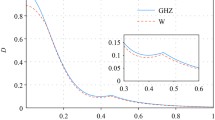Abstract
We demonstrate a new method to achieve the maximum singlet fraction using an entangled mixed two-qubit state as a resource. For this, we establish a tight upper bound on singlet fraction and show that the maximal singlet fraction obtained in Verstraete and Verschelde (Phys Rev Lett 90:097901(1)–097901(4), 2003) does not attain the upper bound on the singlet fraction derived here. Interestingly, we found that the required upper bound can, in fact, be achieved using local filtering operations.

Similar content being viewed by others
References
Einstein, A., Podolsky, B., Rosen, N.: Can quantum-mechanical description of physical reality be considered complete? Phys. Rev. 47, 777–780 (1935)
Schrodinger, E.: Die gegenwärtige situation in der quantenmechanik. Naturwissenschaften 23, 807–812 (1935)
Horodecki, R., Horodecki, P., Horodecki, M., Horodecki, K.: Quantum entanglement. Rev. Mod. Phys. 81, 865–942 (2009)
Bennett, C.H., Brassard, G., Crepeau, C., Jozsa, R., Peres, A., Wootters, W.K.: Teleporting an unknown quantum state via dual classical and Einstein–Podolsky–Rosen channels. Phys. Rev. Lett. 70, 1895–1899 (1993)
Bennett, C.H., Wiesner, S.: Communication via one-and two-particle operators on Einstein–Podolsky–Rosen states. Phys. Rev. Lett. 69, 2881–2884 (1992)
Broadfoot, S., Dorner, U., Jaksch, D.: Entanglement percolation with bipartite mixed states. Eur. Phys. Lett. 88, 50002 (2009)
Gisin, N., Ribordy, G., Tittel, W., Zbinden, H.: Quantum cryptography. Rev. Mod. Phys. 74, 145–195 (2009)
Zanardi, P., Lloyd, S.: Topological protection and quantum noiseless subsystems. Phys. Rev. Lett. 90, 067902 (1)–067902 (4) (2003)
Duan, L.M., Guo, G.C.: Preserving coherence in quantum computation by pairing quantum bits. Phys. Rev. Lett. 79, 1953–1956 (1997)
Verstraete, F., Verschelde, H.: Optimal teleportation with a mixed state of two qubits. Phys. Rev. Lett. 90, 097901(1)–097901(4) (2003)
Horodecki, M., Horodecki, P., Horodecki, R.: General teleportation channel, singlet fraction, and quasidistillation. Phys. Rev. A 60, 1888–1898 (1999)
Taketani, B.G., de Melo, F., de Matos Filho, R.L.: Optimal teleportation with a noisy source. Phys. Rev. A 85, 020301(R) (2012)
de Beaudrap, N., Ohliger, M., Osborne, T.J., Eisert, J.: Solving frustration-free spin systems. Phys. Rev. Lett. 105, 060504(1)–060504(1) (2010)
Burkard, G.: Spin-entangled electrons in solid-state systems. J. Phys. Condens. Matter 19, 233202 (2007)
Simmons, S., et al.: Entanglement in a solid-state spin ensemble. Nature 470, 69–72 (2011)
Clark, S.G., Parkins, A.S.: Entanglement and entropy engineering of atomic two-qubit states. Phys. Rev. Lett. 90, 047905 (1)–047905 (4) (2003)
Cai, J., Guerreschi, G.G., Briegel, H.J.: Quantum control and entanglement in a chemical compass. Phys. Rev. Lett. 104, 220502 (1)–220502 (4) (2010)
Fang, Y., Loparo, K.A., Feng, X.: Inequalities for the trace of matrix product. IEEE Trans. Autom. Control 39, 2489–2490 (1994)
Dembo, A.: Bounds on the extreme eigenvalues of positive-definite Toeplitz matrices. IEEE Trans. Inform. Theory 34, 352–355 (1988)
Park, D., Lee, B.G.: On determining upper bounds of maximal eigenvalue of Hermitian positive-Definite Matrix. IEEE Signal Process. Lett. 10, 267–269 (2003)
Author information
Authors and Affiliations
Corresponding author
Rights and permissions
About this article
Cite this article
Adhikari, S., Kumar, A. Upper bound on singlet fraction of two-qubit mixed entangled states. Quantum Inf Process 15, 2797–2803 (2016). https://doi.org/10.1007/s11128-016-1295-y
Received:
Accepted:
Published:
Issue Date:
DOI: https://doi.org/10.1007/s11128-016-1295-y




